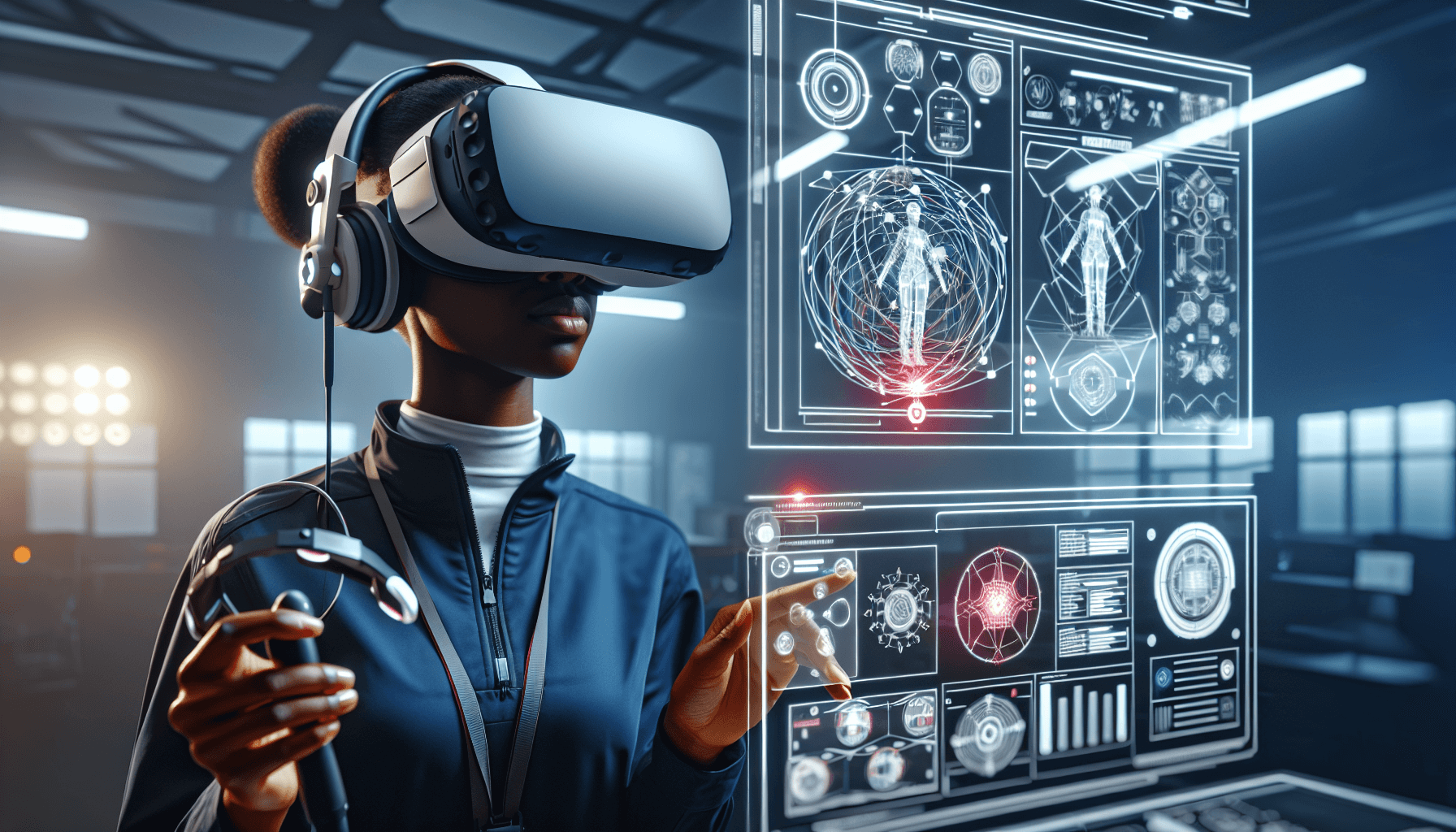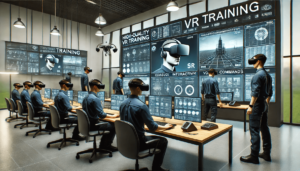In an era where technological advancements are revolutionizing how skills are developed and knowledge is transferred, virtual reality software stands out as an innovative training solutions. This technology has become a tangible tool in the realm of skill development, offering immersive learning experiences that enhance knowledge understanding and retention. Virtual reality training employs VR simulations to create interactive training environments that mimic real-life scenarios, enabling learners to practice and hone their skills in a safe, controlled setting. By leveraging virtual reality software, organizations can significantly improve the effectiveness of their training programs, particularly in fields requiring hands-on experience, such as safety training.
This article explores the best practices for implementing virtual reality (VR) software in training programs. We will cover everything from understanding the fundamentals of VR for training to the setup and design of VR training simulators.
One critical aspect we will discuss is designing effective VR training programs that maximize immersive learning and interactive training. We will provide insights on how to create engaging and impactful experiences for trainees. Additionally, we will delve into measuring the effectiveness of these programs in terms of skill development and learning retention. We will discuss various methods and metrics to evaluate the success of VR training initiatives.
By providing a comprehensive overview of using virtual reality software to create engaging and effective training solutions, this article aims to equip educators, trainers, and organizations with the knowledge they need to harness the full potential of VR simulations in their training endeavors.
Understanding VR Training
What is VR Training?
Virtual Reality Training is a cutting-edge approach that utilizes immersive simulations to create realistic environments for training purposes. This method allows trainees to engage in a 360-degree, interactive learning experience that closely mimics real-world scenarios, enhancing both skill acquisition and knowledge retention. Trainees can interact with virtual objects, manipulate 3D environments, and receive real-time feedback on their actions, making the training process both engaging and effective.
Key Features of VR Training
- High-Quality Immersion: VR training programs are designed to offer a realistic experience that includes detailed graphics and simulations mirroring real-life situations. This high level of immersion aids in creating muscle memory and cognitive associations essential for learning new skills.
- Interactivity: The ability to interact within the virtual environment is what sets VR training apart from traditional learning methods. Features such as gesture recognition, voice commands, and interactive scenarios enhance the learning experience by allowing trainees to practice skills in a hands-on manner. This level of interaction is attainable thanks to high-quality VR headsets, which provides more immersiveness than reading or watching a video.
- Customization: Tailoring training modules to fit individual needs and skill levels is a crucial aspect of VR training. Customizable difficulty settings, learning paths, and focused skill development ensure that the training is relevant and impactful for each user.
- Scalability and Support: Effective VR training programs can support multiple users simultaneously and are adaptable to various hardware configurations. They also provide robust user support and regular updates to keep the training relevant and effective over time.
Types of VR Training Solutions
VR training solutions can be broadly categorized into two types:
- Soft Skills Training: These programs use VR to simulate social interactions and scenarios where communication, empathy, and decision-making are practiced. Trainees can engage in realistic role-play scenarios that help in developing interpersonal skills .
- Hard Skills Training: Focused on technical skills, these training programs allow trainees to operate virtual machinery, engage in safety protocols, and perform complex tasks that would be risky or expensive to simulate in real life. This type of training is particularly beneficial in industries like healthcare, engineering, and manufacturing where precision and safety are paramount .
By integrating these features and training types, VR training programs offer a comprehensive tool for enhancing professional skills in a safe, controlled, and cost-effective manner. The immersive nature of VR not only improves learning outcomes but also makes the training process more enjoyable and engaging for participants.
Setting Up VR Training
Selecting the Right VR Hardware
When setting up VR training, selecting the appropriate hardware is crucial. The choice of VR headset impacts the overall training experience significantly. Key considerations include comfort, resolution, tracking capabilities, and whether the headset is tethered or standalone. Popular VR headsets like Oculus Rift, HTC Vive, and PlayStation VR offer varying features that cater to different training needs. For instance, standalone devices like the Oculus Quest 2 provide ease of use and portability, ideal for scenarios that require flexibility away from a fixed PC setup. In contrast, tethered devices offer higher graphics quality but require a connection to a powerful PC, making them suitable for graphically intensive applications.
Choosing Suitable VR Software
The VR software is responsible for creating the immersive environment necessary for effective training. When choosing VR software, it’s essential to consider the level of realism, interactive elements support, and ease of content creation. Platforms like TrainBeyond provide user-friendly solutions with comprehensive features for content creation, hosting, and analytics. However, for those requiring more control over the design and development of training modules, tools like Unity or Unreal Engine offer flexibility and powerful customization options. It’s important to ensure the software is compatible with the chosen hardware to avoid integration issues.
Implementation Steps
To implement VR training effectively, organizations should start by equipping themselves with the right hardware and software. This involves selecting a VR headset that aligns with the training objectives and ensuring the VR software can deliver the desired interactive experiences. Following hardware and software setup, the next steps include developing or customizing the VR training modules to meet specific organizational needs. This might involve tailoring scenarios to reflect real-world tasks or focusing on particular skills development. Additionally, integrating motion sensors and hand controllers can enhance the interactivity and realism of the training environment, providing trainees with a hands-on experience that promotes better learning retention.
By carefully selecting the right equipment and software and following structured implementation steps, organizations can set up a VR training program that is both effective and engaging.
Designing Effective VR Training Programs
Creating Realistic Scenarios
To design effective VR training programs, one must start with a solid foundation by developing an engaging narrative that resonates with the trainees. The creation process begins with identifying a relevant scenario that mirrors real-life situations the trainees might face. This could involve complex environments such as intricate machinery operations or workplace emergencies. The storyline should include key elements such as the specific tasks to be performed, the protocols to follow, and potential challenges that might arise. As the narrative unfolds, it’s crucial to ensure that the scenarios are immersive and interactive, providing trainees with choices that influence the outcome, thereby enhancing their decision-making and problem-solving skills.
Incorporating Feedback Mechanisms
Effective VR training programs leverage various feedback mechanisms to enhance learning outcomes. These include haptic, auditory, visual, and verbal feedback, each playing a critical role in reinforcing learning. Haptic feedback, for example, can simulate the sensation of touch and resistance, which is particularly useful in scenarios requiring physical interaction, like surgery or mechanical repairs. Auditory feedback helps in creating an immersive auditory environment, essential in scenarios like piloting or emergency response training. Visual feedback displays progress and corrects mistakes in real-time, and verbal feedback provides direct communication from the instructor, facilitating a deeper understanding and correction of errors.
Customization for Various Industries
Customization is key in VR training, allowing the program to cater to the specific needs of various industries. For instance, a VR training program for the oil and gas industry might focus on drilling procedures and well control techniques, while one for manufacturing might concentrate on machinery operation and safety procedures. The ability to tailor the training modules to address specific skills and knowledge enhances relevance and engagement among learners. Furthermore, scenario-based learning in virtual reality software can adapt to include multiple realistic situations, providing a comprehensive training experience that covers various aspects of the job.
By integrating these elements into VR training programs, organizations can create powerful, immersive learning experiences that significantly improve skill acquisition and job performance.
Measuring the Effectiveness of VR Training
Tracking Performance Metrics
To gauge the success of virtual reality training programs, organizations rely on various performance metrics. These metrics include progress rates, completions, and the frequency of replays, which help ensure learners are on the right track . Additionally, detailed performance data such as decisions made during training, timing, and body movements provide insights into learner engagement and effectiveness. For example, retinal eye tracking and body movements are monitored to assess learners’ focus and physical response within the training scenario.
Analyzing User Feedback
User feedback is pivotal in evaluating the effectiveness of VR training. Organizations collect feedback through post-training surveys and direct comments from users, which help identify strengths and weaknesses in the training content . This qualitative data is essential for understanding the learners’ emotional and educational connection to the material, with VR training showing significantly higher emotional connections compared to traditional methods. By analyzing this feedback, trainers can adjust the training modules to better meet learners’ needs and enhance the overall training effectiveness.
Continuous Improvement Strategies
Continuous improvement in VR training is achieved by using real-time data to adapt training programs. Advanced virtual reality platforms integrate analytics that allow for the modification of training scenarios based on learner performance and feedback. This dynamic approach ensures that the training remains relevant and effective, addressing the individual needs of users. Furthermore, ongoing evaluation strategies, such as comparing learner performance before and after training, are crucial for measuring the long-term impact of VR training on organizational goals.
By implementing these strategies, organizations can not only measure but also enhance the effectiveness of their VR training programs, leading to better learning outcomes and higher returns on investment.
FAQs
- What are the steps to effectively implement VR training in a business?
To effectively implement VR training within your organization, follow these five essential steps: Firstly, identify the specific training needs of your organization. Secondly, choose the most suitable VR solution that meets these needs. Thirdly, develop or choose the appropriate content for your VR training. Fourthly, conduct pilot programs and collect feedback to refine the training experience. Lastly, scale the implementation gradually and ensure ongoing support to ease your team into VR training effectively. - How does virtual reality benefit employee training?
Virtual reality transforms employee training by providing immersive learning experiences. In VR settings, employees can experience realistic job scenarios, which offers a form of personalized on-the-job training. This approach significantly reduces the need for traditional training methods such as lengthy courses, manual reviews, production halts, walk-arounds, and role-playing exercises. - Can you give an example of how virtual reality can be used for different types of training?
A prime example of virtual reality applied to training is the use of flight simulators for pilots. These simulators offer a highly realistic and immersive virtual environment where pilots can practice flying and manage emergency situations without real-world risks. - Why are VR simulations crucial for training purposes?
VR simulations are vital for training because they enhance learning retention. Research indicates that interactive and immersive experiences help individuals remember information more effectively by keeping them engaged and emotionally invested. As a result, VR makes training sessions more impactful and improves the retention of knowledge.


